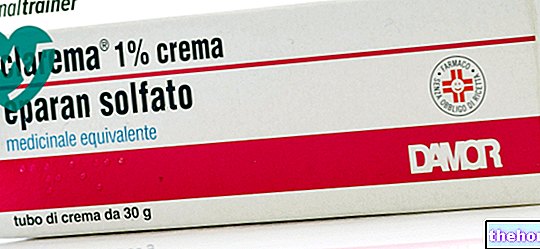Active ingredients: Spiramycin
ROVAMICIN 3,000,000 I.U. film-coated tablets
Why is Rovamycin used? What is it for?
PHARMACOTHERAPEUTIC CATEGORY
Systemic antibacterials, macrolides.
THERAPEUTIC INDICATIONS
Rovamycin is indicated in infections with sensitive germs.
- Infections of the oral cavity: periodontal disease and gingivitis, adjuvant in the treatment of alveolar pyorrhea;
- Respiratory tract infections: nasopharyngitis, angina, laryngitis, otitis media, bronchitis, bronchopneumonia, pneumonia, lung abscess, empyema;
- Various infections: whooping cough, erysipelas, scarlet fever, gonorrhea;
- Soft tissue infections: pyoderma, furunculosis, abscesses, infected sores;
- Treatment of bronchopulmonary bacterial complications of influenza and exanthematous diseases.
Contraindications When Rovamycin should not be used
Hypersensitivity to the active substance or to any of the excipients.
Precautions for use What you need to know before taking Rovamycin
It is always advisable, during prolonged treatments with high doses, to carry out periodic checks of the blood count and liver function.
Interactions Which drugs or foods can modify the effect of Rovamycin
Tell your doctor if you are taking, have recently taken or might take any other medicines.
Cross-resistance with oleandomycin, erythromycin and with macrolides in general is possible.
Levodopa: inhibition of the absorption of carbodopa with a decrease in the plasma level of levodopa.
Where necessary, patients should be carefully monitored and the levodopa dosage adjusted.
There are no known drug interactions with other drugs.
Warnings It is important to know that:
Spiramycin does not reach therapeutically useful levels in the cerebrospinal fluid, therefore it is ineffective in the treatment of meningitis.
Rare cases of acute haemolysis have been reported in patients with glucose 6-phosphate dehydrogenase deficiency; the use of spiramycin in this patient population is therefore not recommended.
Pregnancy and breastfeeding
If you are pregnant or breast-feeding, think you may be pregnant or are planning to have a baby, ask your doctor or pharmacist for advice before taking this medicine.
The safety of the use of spiramycin in pregnancy has not been evaluated in controlled studies. However, spiramycin has been used for many years without particular problems in pregnant women.
Spiramycin is excreted in breast milk therefore use by breastfeeding mothers is not recommended.
Effects on ability to drive and use machines
There is no known interference with the ability to drive vehicles and use machines.
Dose, Method and Time of Administration How to use Rovamycin: Posology
Adults
The daily dose is usually 2-3 tablets of 3,000,000 I.U. divided into 2-3 administrations.
The tablets should be swallowed, without chewing, with plenty of liquid.
Children
The daily dosage varies from 150,000 to 225,000 IU / kg body weight depending on the severity of the disease to be treated: this dose must be divided into 3/4 administrations. Treatment must be continued for at least 48 hours after the disappearance of clinical signs or bacteriological of the infection.
Patients with impaired renal function:
No studies have been performed in patients with impaired renal function after administration of rovamycin; however, as only a small portion of the drug is eliminated via the kidney (oral and i.v.) therefore no dosage adjustment is necessary.
Overdose What to do if you have taken too much Rovamycin
In case of accidental ingestion of an excessive dose of Rovamycin, notify your doctor immediately or go to the nearest hospital.
There is no specific antidote for spiramycin in the event of an overdose.
In case of suspected overdose, symptomatic supportive treatment is recommended.
If you have any further questions on the use of this medicine, ask your doctor or pharmacist
Side Effects What are the side effects of Rovamycin
Like all medicines, this medicine can cause side effects, although not everybody gets them.
Undesirable effects include:
Gastrointestinal disorders:
Nausea, vomiting, diarrhea and very rare cases of pseudomembranous colitis have been reported for the oral forms.
Hypersensitivity reactions:
Rash, hives, itching; very rarely: angioedema, anaphylactic shock.
Isolated cases of vasculitis, including Henoch-Schonlein purpura.
Nervous system disorders:
Occasional cases of transient paraesthesia.
hepatobiliary pathologies:
Very rare cases of impaired liver function have been reported.
Cases of cholestatic and mixed hepatitis have been reported.
Disorders of the blood and lymphatic system:
Very rare cases of acute haemolysis have been reported (see Special warnings).
Compliance with the instructions contained in the package leaflet reduces the risk of undesirable effects.
If you get any side effects, talk to your doctor or pharmacist. This includes any possible side effects not listed in this leaflet.
Expiry and Retention
Expiry: see the expiry date indicated on the package.
The expiry date indicated refers to the product in intact packaging, correctly stored.
WARNING: do not use the medicine after the expiry date indicated on the package.
Keep this medicine out of the reach and sight of children.
Do not throw any medicines via wastewater or household waste. Ask your pharmacist how to throw away medicines you no longer use. This will help protect the environment.
COMPOSITION
One film-coated tablet contains:
Active principle: spiramycin 3,000,000 I.U.
Excipients: anhydrous colloidal silica, hyprolose, magnesium stearate, hypromellose, maize starch, macrogol 6,000, carmellose sodium, microcrystalline cellulose, titanium dioxide.
PHARMACEUTICAL FORM AND CONTENT
Film-coated tablets.
Packaging: Blister packs of 12 film-coated tablets.
Source Package Leaflet: AIFA (Italian Medicines Agency). Content published in January 2016. The information present may not be up-to-date.
To have access to the most up-to-date version, it is advisable to access the AIFA (Italian Medicines Agency) website. Disclaimer and useful information.
01.0 NAME OF THE MEDICINAL PRODUCT
ROVAMICIN
02.0 QUALITATIVE AND QUANTITATIVE COMPOSITION
One film-coated tablet contains:
Active principle: spiramycin 3,000,000 I.U.
For the full list of excipients, see section 6.1.
03.0 PHARMACEUTICAL FORM
Film-coated tablets.
04.0 CLINICAL INFORMATION
04.1 Therapeutic indications
Rovamycin is indicated in infections with sensitive germs.
• Oral infections: periodontal disease and gingivitis, adjuvant in the treatment of alveolar pyorrhea;
• Respiratory tract infections: nasopharyngitis, angina, laryngitis, otitis media, bronchitis, bronchopneumonia, pneumonia, lung abscess, empyema;
• Various infections: whooping cough, erysipelas, scarlet fever, gonorrhea;
• Soft tissue infections: pyoderma, furunculosis, abscesses, infected sores;
• Treatment of bronchopulmonary bacterial complications of influenza and exanthematous diseases.
04.2 Posology and method of administration
Adults
The daily dose is usually 2-3 tablets of 3,000,000 I.U. divided into 2-3 administrations.
The tablets should be swallowed, without chewing, with plenty of liquid.
Children
The daily dosage varies from 150,000 to 225,000 IU / kg body weight depending on the severity of the condition to be treated: this dose must be divided into ¾ administrations. Treatment must be continued for at least 48 hours after the disappearance of the clinical or bacteriological signs of the disease. "infection.
Patients with impaired renal function:
No studies have been performed in patients with impaired renal function after administration of Rovamycin; however, as only a small portion of the drug is eliminated via the kidney (oral and i.v.) therefore no dosage adjustment is necessary (see section 5.2).
04.3 Contraindications
Hypersensitivity to the active substance or to any of the excipients.
04.4 Special warnings and appropriate precautions for use
It is always advisable, during prolonged treatments with high doses, to carry out periodic checks of the blood count and liver function.
Spiramycin does not reach therapeutically useful levels in the cerebrospinal fluid, therefore it is ineffective in the treatment of meningitis.
Rare cases of acute haemolysis have been reported in patients with glucose 6-phosphate dehydrogenase deficiency; the use of spiramycin in this patient population is therefore not recommended.
04.5 Interactions with other medicinal products and other forms of interaction
Cross-resistance with oleandomycin, erythromycin and with macrolides in general is possible.
Levodopa: inhibition of the absorption of carbodopa with a decrease in the plasma level of levodopa.
Where necessary, patients should be carefully monitored and the levodopa dosage adjusted.
There are no known drug interactions with other drugs.
04.6 Pregnancy and lactation
Pregnancy
The safety of the use of spiramycin in pregnancy has not been evaluated in controlled studies. However, spiramycin has been used for many years without particular problems in pregnant women.
Feeding time
Spiramycin is excreted in breast milk therefore use by breastfeeding mothers is not recommended.
04.7 Effects on ability to drive and use machines
There is no known interference with the ability to drive vehicles and use machines.
04.8 Undesirable effects
Undesirable effects include:
Gastrointestinal disorders:
Nausea, vomiting, diarrhea and very rare cases of pseudomembranous colitis have been reported for the oral forms.
Hypersensitivity reactions:
Rash, hives, itching; very rarely: angioedema, anaphylactic shock.
Isolated cases of vasculitis, including Henoch-Schonlein purpura.
Nervous system disorders:
Occasional cases of transient paraesthesia.
Hepatobiliary disorders:
Very rare cases of impaired liver function have been reported.
Cases of cholestatic and mixed hepatitis have been reported
Disorders of the blood and lymphatic system:
Very rare cases of acute haemolysis have been reported (see section 4.4).
04.9 Overdose
There is no specific antidote for spiramycin in the event of an overdose.
In case of suspected overdose, symptomatic supportive treatment is recommended.
05.0 PHARMACOLOGICAL PROPERTIES
05.1 Pharmacodynamic properties
Pharmacotherapeutic group: systemic antibacterials, macrolides.
ATC code J01FA02.
Antibacterial activity.
Spiramycin is an antibiotic of the macrolide family isolated from cultures of Streptomyces ambofaciens. It acts on bacterial cells in the proliferative phase with a bacteriostatic mechanism, by inhibiting ribosomal protein synthesis.
It exerts antibacterial activity on Gram-positive germs such as: Staphylococcus aureus (also strains resistant to penicillins, streptomycin, tetracycline, chloramphenicol, erythromycin); Streptococcus pyogenes; Streptococcus viridans; Streptococcus faecalis; Diplococcus pneumoniae.
It is also effective in infections caused by some Gram-negative germs: Haemophilus pertussis; Neisseria gonorrhoeae and in some rickettsioses and has also been shown to be active against Treponema microdentium, Leptotrichia buccalis and Borrelia vincentii.
Rovamycin has been used with favorable results in some mycoplasma infections, non-specific urethritis and toxoplasmosis. Its efficacy in periodontal diseases has also been demonstrated.
05.2 Pharmacokinetic properties
The intestinal absorption of Rovamycin is satisfactory, with the appearance of the blood peak at the 2nd - 3rd hour.
Plasma protein binding is approximately 10%.
Rovamycin has the characteristic of spreading rapidly into the tissues and in high concentrations.
Antibiotic concentrations up to more than 10 times those in blood have been found in muscle, bone, prostate, kidney, lung, liver.
In milk there are levels of antibiotic about 20-40 times those in serum. Even in the bile, the antibiotic concentrations are much higher than those in the blood.
Diffusion across the blood-water and placental barrier is modest.
Elimination of Rovamycin occurs mainly via the biliary tract, approximately 10% is excreted via the urinary tract.
Other routes of elimination are faeces and glandular secretions (saliva, sweat, etc.).
The plasma biological half-life in subjects with normal renal function is approximately 8 hours.
Patients with impaired renal function:
After oral administration, the unchanged active substance is practically not eliminated via the renal route.
After i.v. renal elimination is very low.
05.3 Preclinical safety data
Acute toxicity data, studied on various animal species and at various posologies, did not provide indications of toxic effects.
Even for prolonged administration the drug did not cause alterations in the various organs.
Rovamycin was also found to be neither embryotoxic nor teratogenic.
06.0 PHARMACEUTICAL INFORMATION
06.1 Excipients
Colloidal anhydrous silica, hyprolose, magnesium stearate, hypromellose, maize starch, macrogol 6,000, carmellose sodium, microcrystalline cellulose, titanium dioxide.
06.2 Incompatibility
No cases of incompatibility have been highlighted.
06.3 Period of validity
4 years.
06.4 Special precautions for storage
This medicine does not require any special storage conditions
06.5 Nature of the immediate packaging and contents of the package
Aluminum / PVC blister.
Packaging: 12 film-coated tablets.
06.6 Instructions for use and handling
No special instructions.
07.0 MARKETING AUTHORIZATION HOLDER
sanofi-aventis S.p.A.
Viale L. Bodio, 37 / B - 20158 Milan
08.0 MARKETING AUTHORIZATION NUMBER
Rovamycin 3,000,000 I.U. film-coated tablets, 12 tablets: A.I.C. n ° 012322020
09.0 DATE OF FIRST AUTHORIZATION OR RENEWAL OF THE AUTHORIZATION
Date of first authorization: 13 July 1985
Last renewal date: 08 February 2010
10.0 DATE OF REVISION OF THE TEXT
December 2012























-nelle-carni-di-maiale.jpg)




